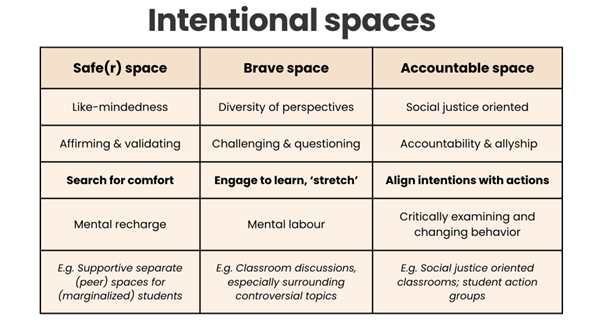To acknowledge diversity and advance a culture of belonging in higher education, it is important to create intentional spaces where people can navigate differences in constructive ways. Below are three types of spaces that serve different but complementary purposes.
In higher education, safe(r) spaces can be:
- Institutional: for example, a space facilitated by a confidential counsellor, for example to discuss sensitive issues and experiences like harassment, discrimination, etc.
- These institutional safe(r) spaces can offer individual support, but can also be a starting point for (institutional) change, especially if issues are formally reported or complaint procedures are put in motion. However, institutional barriers may lead to these spaces not always feeling safe or effective enough. For more information, review the resource: Sara Ahmed – Complaint!
- Student-led: for example, a LGBTQIA+ center led by and for LGBTQIA+ students and allies. A student-led safe(r) space may be facilitated by the institution in terms of physical space, but it is organized on a peer-to-peer basis.
- Staff networks: these are informal networks or spaces led for and by staff, fully independent from or partially facilitated by the institution
Brave spaces are focused on dialogue, learning, and mutual understanding. They acknowledge that in settings like classrooms or team discussions, people bring different perspectives, experiences, and opinions– some of which may clash. In a brave space, participants are encouraged to engage openly, even if that means facing discomfort or disagreement. The goal is not to avoid difficult conversations, but to manage them thoughtfully. A skilled facilitator helps guide the process, setting clear guidelines for discussion to ensure that conversations remain respectful and constructive.
The discussion guidelines for the brave space can be created collectively with the group – each participant bringing in their own needs to engage in potentially sensitive discussions – or can be pre-drafted by the facilitator (for example if the group is too large and time is limited).
Examples of potential brave space guidelines are:
- Do not interrupt others.
- Listen actively and to understand the other, instead of just waiting to speak.
- Give everyone a chance to speak.
- Recognize and embrace friction as evidence that multiple ideas are entering the conversation– not that the group is not getting along.
- If no consensus cannot be reached, agree to disagree.
- Ask for clarification– do not assume or project.
- Recognize we are all speaking from different perspectives, experiences and social positions.
Accountable spaces build on both safe(r) and brave spaces. They explicitly recognize power dynamics and emphasize personal and collective responsibility. Like brave spaces, accountable spaces tend to have (pre-)determined rules and guidelines to navigate the space. In these spaces, participants agree to be held accountable for the impact of their words and actions— not just their intent. Accountable spaces also aim to reduce the burden often placed on marginalized individuals by sharing responsibility for maintaining respectful and equitable dialogue. These spaces tend to work best in groups that already have a strong commitment to equity and inclusion.
Accountable space guidelines are typically similar to brave space guidelines, with extra rules that focus on accountability and equity principles. For example:
- Understand that we are all learning. If you said something offensive or problematic, apologize for your actions or words being offensive– not for the person feeling insulted.
- Give credit where it is due. If you are echoing someone’s previously stated idea, give the appropriate credit.
- Words and tone matter. Be mindful of the impact of what you say, and not just your intent.
- Speak for yourself. Use “I” statements and do not share others’ lived experiences.
- Self-reflect on actionable items to become an ally in your daily work or personal experiences, after leaving the space. Don’t place the burden of educating yourself on others, especially those from equity-deserving communities.
- If you attend as an ally of a community, please allow space for equity-deserving and marginalized communities to share their experiences.
These and the aforementioned brave/accountable space guidelines were adapted from the resource: Elise Ahenkorah – “Safe and Brave Spaces Don’t Work (and What You Can Do Instead)”
These three types of spaces are not mutually exclusive. They serve different needs and can complement one another when all present in an institution:
- Safe(r) spaces help individuals feel supported and validated, which can give them the strength, confidence and support network to engage in more challenging discussions elsewhere.
- Brave and accountable spaces allow for open dialogue and institutional learning, which are essential for driving meaningful change.
Having a mix of these spaces across an institution helps create a healthier, more inclusive environment where all members can learn, grow, and thrive.

- Understand the differential qualities of safe(r), brave and accountable spaces
- Understand and explore how these spaces can advance IDEA in your own institutional context
Below are two activities, to be done in groups or individually, to explore how the principles of safe(r), brave and accountable spaces can be made relevant for your institution, department or classroom. Choose and adapt one or both activities to fit the needs of your group and situation.
For who: Support staff, faculty and others who want to re-imagine the safe(r) spaces present at their institution, for example to create a plan for new support services.
Instruction:
- Review the key aspects and differences between safe(r), brave and accountable spaces using the information and resources of this module. If leading a group, present the relevant information using the pre-made presentation slides, or your own. Discuss the key aspects, opportunities and challenges that come with organizing safe(r) spaces. You may also research and include examples of safe(r) spaces from other institutions for inspiration.
- Individually or in groups, discuss the kinds of safe(r) spaces present at your institution and how these could look different to better fit the needs of the people that are served. Possible discussion questions can be:
- What groups/people are in need of safe(r) spaces at your institution/faculty/department?
- What could these spaces look like?
- Who should be responsible to organize and ensure safety in these spaces? (e.g. institutional, student-led, etc.)
For who: Educators who want to create more constructive, respectful, safe(r) learning environments in their classroom.
Instructions:
- Theory: Review the key aspects and differences between safe(r), brave and accountable spaces using the information and resources of this module. If leading a group, present the relevant information using the pre-made powerpoint slides or your own. Choose and explain what kind of space you intend your classroom to be and why (brave/accountable space).
- Practice: Individually, in groups with other educators, or in a classroom with your students, draft conditions that you want to put in place in your classroom in order to ensure a more constructive, respectful learning environment in which everyone feels ready to deal with potential discomfort. When drafting these conditions, draw upon brave and/or accountable space principles, and consider:
- Clearly positioning your role as educator/facilitator of the space.
- Your expectations from students.
- How to ensure constructive, respectful, but ‘brave’ discussions.
- Red lines (and accountability).
Ahenkorah, E. (2020). “Safe and Brave Spaces Don’t Work (and What You Can Do Instead)” [Blog post] https://medium.com/@elise.k.ahen/safe-and-brave-spaces-dont-work-and-what-you-can-do-instead-f265aa339aff
Ahmed, S. (2021). Complaint! Duke University Press. https://www.dukeupress.edu/complaint
American Academy of Arts & Sciences. (2019). “John Palfrey – Safe Spaces, Brave Spaces” [Youtube video] https://www.youtube.com/watch?v=xYRe5ndgmk0
Palfrey, P. (2017) Safe Spaces, Brave Spaces: Diversity and Free Expression in Education. MIT Press. https://direct.mit.edu/books/book/3638/Safe-Spaces-Brave-SpacesDiversity-and-Free
Rolffs, D. (2021). “What do you mean brave spaces, I want safety” [Blog post] https://l3catalystgroup.com/blog/what-do-you-mean-brave-spaces-i-want-safety

